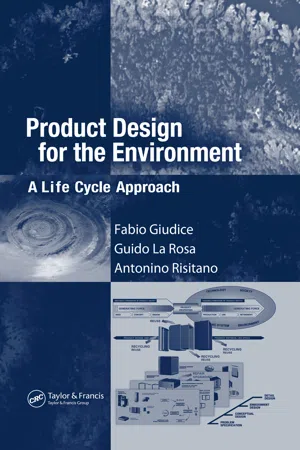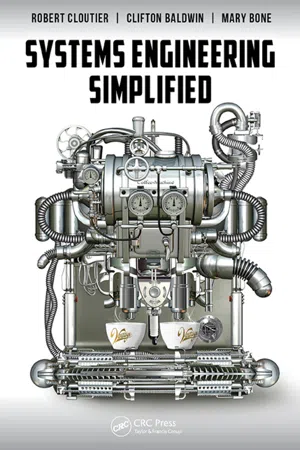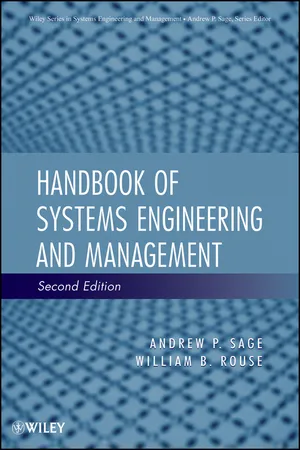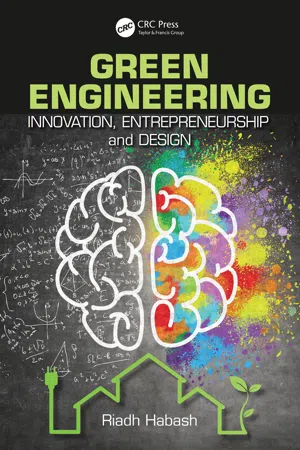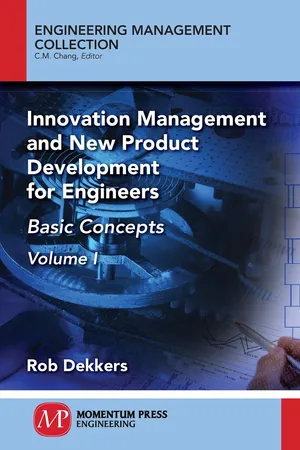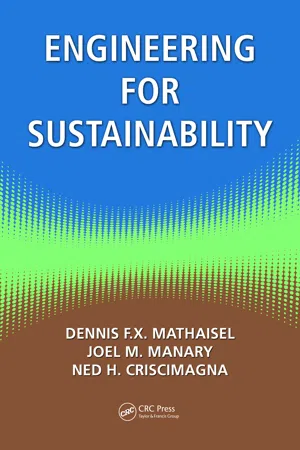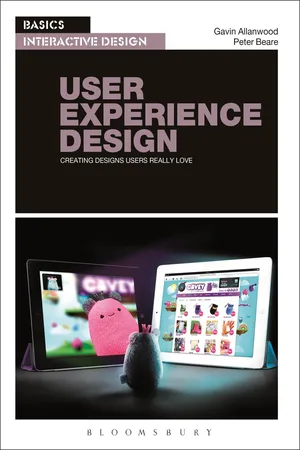Technology & Engineering
Design Life Cycle
The design life cycle refers to the stages a product goes through from concept to retirement. It typically includes phases such as research, design, development, testing, production, and maintenance. This systematic approach ensures that products are designed, manufactured, and maintained in a way that meets quality, cost, and time requirements.
Written by Perlego with AI-assistance
Related key terms
1 of 5
8 Key excerpts on "Design Life Cycle"
- eBook - PDF
Product Design for the Environment
A Life Cycle Approach
- Fabio Giudice, Guido La Rosa, Antonino Risitano(Authors)
- 2006(Publication Date)
- CRC Press(Publisher)
Besides, the very concept of a product understood as integral with its life cycle and within the environmental, social, and technological context in which the cycle develops (i.e., the product–system discussed earlier) is no more than the theorization of a single system for the purposes of design (Keoleian and Menerey, 1993). To what degree the life cycle approach is suited to the design activity is confirmed by the widely held view that the phase of product design and development must be considered the first phase of the cycle, thus becoming an integral part of the product–system (Alting, 1993; Tomiyama et al., 1997; Tipnis, 1998; Hundal, 2002). Life Cycle Design (LCD), which is the application of the life cycle concept to the design phase of the product development process, denotes a design intervention which takes into consideration all the phases of a product’s life cycle (development, production, distribution, use, maintenance, disposal, and recovery) in the context of the entire design process, from concept defini-tion to detailed design development (Kusiak, 1993). It uses design models, methodologies, and tools to reconcile the evolution of the product, from 64 Product Design for the Environment conception to retirement, with a wide range of design requirements related to different phases of the life cycle (e.g., ease of production, functional perfor-mance, maintainability, and environmental impact) (Ishii, 1995). From the very beginning, a term widely used in this field is Life Cycle Engineering (LCE). Although it would be more correct to apply this to an approach to the life cycle of all the functions of engineering, not solely that of design, LCE and LCD are generally used without distinction (Zhang et al., 1995). More recently, LCE has been assimilated to the wider concept of “a decision-making methodology that considers performance, environ-mental and cost requirements for the duration of a product” (Wanyama et al., 2003). - eBook - PDF
Design Synthesis
Integrated Product and Manufacturing System Design
- Graeme Arthur Britton, Seppo Torvinen(Authors)
- 2013(Publication Date)
- CRC Press(Publisher)
163 © 2008 Taylor & Francis Group, LLC 11 Life Cycle Analysis Introduction A life cycle is a model of a repeatable process, which is the complete life cycle of a system. For a biological system the process starts with conception and ends when the system dies. For a designed system the process starts from the time it is conceived and ends when it is retired. The process is divided into phases or stages; for example, a software development life cycle might be divided into specification, design, coding and assurance. Each phase requires different methods and skills. The phases may overlap and iterate, but usually start in the sequence shown in the life cycle. Life cycles are used to reduce the time and cost in setting up new projects and processes; to improve learning, quality and risk management; and to facilitate correct allocation of resources to the different phases of system development. Learning is improved through repetition and quality is improved through learning and compliance to procedures. Risk manage-ment is improved because the model ensures critical activities are identi-fied and controlled and that feedback from prior cycles is used to improve future activities. The main disadvantage of using a life cycle is it may inhibit process innovation. The concept map for this chapter is depicted in Figure 11.1. The chapter presents a general system life cycle model. It describes some of the main cycles used in industry to develop products and manufacturing systems and shows how intersecting life cycles can harmonise two or more develop-ment processes. The cycles do not include technology development, as it is more effective for technologies to be developed separately from the design- manufacture life cycle, as discussed in Chapter 3. A generic life cycle that can be applied to all systems is shown in Figure 11.2. The cycle starts with the design phase. It is here the system is first conceived. - eBook - PDF
- Robert Cloutier, Clifton Baldwin, Mary Alice Bone(Authors)
- 2015(Publication Date)
- CRC Press(Publisher)
17 2 The System Life Cycle Here systems engineering is focused on addressing why a system is needed, what the system must do, and then how the system will accomplish the tasks over the entire system life cycle from conception to disposal (Figure 2.1). Therefore, understand-ing the system life cycle is important for systems engineers since many times only the design phase is addressed in introductory engineering material. Being able to implement a solution across the system life cycle is what forces systems engineers to understand other areas of study, such as management, manufacturing, marketing, sales, and customer support, since these areas all intersect with the system in the life cycle. Figure 2.2 shows the system life cycle that most systems will go through. While some systems may go through a phase of the cycle at a different rate than another system, the phases remain the same. It is also important to point out that while Figure 2.2 shows clear breaks between the phases, it almost never happens this way in real life. In reality a systems engineer must be able to break a system down into subsystems, components, or some other elements and move each piece of the system through the process while also moving the whole system through the life cycle. Taking this dual view of both the pieces and the whole is arguably one of the most important skills of a systems engineer. So how does this life cycle look in real life? We will use a dishwasher to show the flow through a top-level life cycle (Figure 2.3). You may ask why it is important for the systems engineer to consider the entire life cycle. While many engineers are only trained in their specific area of expertise (e.g., electrical, mechanical, manufactur-ing, etc.), there needs to be someone to consider the entire system despite its stage of development. For example, an electrical engineer is concerned with the power system of a dishwasher. The machine has to work with household current and not electrocute anyone. - eBook - ePub
- Andrew P. Sage, William B. Rouse(Authors)
- 2011(Publication Date)
- Wiley-Interscience(Publisher)
1 Systems Engineering Life Cycles: Life Cycles for Research, Development, Test, and Evaluation; Acquisition; and Planning and Marketing F. G. PATTERSON, JR. 1.1 INTRODUCTIONIn this chapter we discuss a number of process models, which we also refer to as life cycles . In so doing, we discuss what a life cycle is with respect to our concepts of systems engineering, systems thinking, and the systems approach. As engineers, we ask “What is a life cycle good for?” and “How does it work?” As students, we are constantly looking for fundamental principles and models with which to structure an understanding of our subject (Bruner, 1960). Thus, a study of life-cycle models is an appropriate way to begin an investigation of systems engineering.Our understanding of life cycles is based on our understanding of systems engineering or the systems engineering approach. Johnson et al. (1967) define a system as “an organized or complex whole; an assemblage or combination of things or parts forming a complex or unitary whole ... more precisely, an array of components designed to accomplish a particular objective according to plan.” An unorganized collection of parts has no purpose. As pointed out as early as in the writings of Aristotle (Ogle, 1941), it is exactly the identification of purpose with the organization of components that defines the approach that we refer to as systems engineering.Ackoff (1981) uses the term “systems thinking” to describe a means for understanding an entity in terms of its purpose. He formulates the concept of systems thinking as three steps: 1. Identify a containing whole (system), of which the thing to be explained is a part. 2. Explain the behavior or properties of the containing whole.3. Explain the behavior or properties of the thing to be explained in terms of its role(s) or function(s) within its containing whole.Strategic planning is purposeful, goal oriented, and goal setting. Systems engineering is the analysis and synthesis of parts, with an eye toward the goal set by strategic planning. Focusing on the problem is analysis - eBook - ePub
Green Engineering
Innovation, Entrepreneurship and Design
- Riadh Habash(Author)
- 2017(Publication Date)
- CRC Press(Publisher)
The design of products for sustainability is a complex issue that involves several different topics. It has been shown that significant advances toward sustainable product design can be gained by appropriate improvements in life cycle design (LCD) processes (Ping and Wang 2007). Existing approaches to supporting sustainable product design tend to focus on the later stages of product development, focusing on assessment of environmental impact costs after a design is selected, but not to include the early stages of design decision-making. However, support for more sustainable decisions during the conceptual design stages can lead to several advantages for enterprises (Eddy 2014).Figure 10.2 Key technical requirements of sustainable engineering.At its core, sustainability is about how the flow of materials is managed to preserve and improve the quality of life for future generations (Ceridon 2011). Figure 10.2 shows the key technical requirements of sustainable engineering centered by sustainable design thinking.10.4 Role of technology in sustainable design
The 21st century is likely to become the solar-hydrogen-energy efficiency century.Charles Secrett Friends of the Earth10.4.1 Innovation, technology, and design
Innovation is the core of sustainability, while sustainable technology is a means to assure that future actions are more sustainable and be an economic driver. Design on the other hand is an innovative decision-making process that intends to find a sustainability balance of trade-offs in the building of a product or service that best meets customer and other stakeholder preferences. Aspects of balance in design involve creativity, synthesis, and innovation; problem solving and technology selection; and planning for use, disuse, abuse, and reuse within all sectors.To fully understand the role of technology in achieving sustainability, we must first acknowledge the role that technology had in providing us the means to stray off the pathway to sustainability in the first place. Instead of “leveraging technology for sustainability,” we are caught in the cycle of using technology to mitigate the problems we caused with our prior increase in technological knowledge (Tlusty 2015). - eBook - ePub
- Rob Dekkers(Author)
- 2018(Publication Date)
- Momentum Press(Publisher)
CHAPTER 3 PRODUCT AND SERVICE LIFE -CYCLE MANAGEMENTChapter 2 has covered which processes, methods, and tools are used to convert ideas and inventions related to technological and scientific advances into feasible designs for products and services that can be commercialized. This implies that commercialization is a central focus of new product and service development. In the first instance, this seems to be about markets and market segments, competitive products and services, and the related business models. In addition to the initial commercialization, it is also keeping products and services competitive over a longer period of time. Managing this so-called product and service life-cycle, from design and engineering to disposal and waste, is not only a matter of marketing and sales, but also dependent on improving the design of existing product and services.To this purpose, the chapter begins by describing in Section 3.1 what these lifecycles for products and services are in more detail. After presenting two perspectives on lifecycles and systems engineering, a case is introduced to illustrate the concepts. Section 3.2 connects the lifecycle of products and services to advancements in technology and innovation. Continuing with technology, Section 3.3 goes into more detail about cycles for technology. This includes the acceptance of technologies by customers and users. Section 3.4 describes the generations of innovation processes that show how all processes for innovation and technology management and for new product and service development have become more complex and intricate over the course of time. Section 3.5 concludes this chapter by providing on overview of strategic tools for making decisions about new products and services related to technological developments.3.1 PRODUCT AND SERVICE LIFE-CYCLESThere are two perspectives on the life cycle of products and services related to innovation management. In the first perspective, it is about markets and market segments, competitive products and services, and the related business models; this covers how products and services are positioned within the dynamics of markets from an innovation point of view. In addition to these considerations for new products and services, the life cycle of products and services also covers manufacturing, logistics, recycling, disposal, and so on. This is the second perspective on the life cycle. Both perspectives are complementary to each other and relevant to innovation management, albeit in different ways. - eBook - PDF
- Dennis F.X. Mathaisel, Joel M. Manary, Ned H. Criscimagna(Authors)
- 2012(Publication Date)
- CRC Press(Publisher)
Sustainability Engineering Processes ◾ 147 The fundamental design activities are stakeholder requirements definition, product techni-cal requirements definition, logical solutions representation (functional analysis and allocation), physical solutions representation (design synthesis), and specified requirements definition. They are all balanced by other processes such as assessment, control, and product analysis. These pro-cesses are used to make decisions and track requirements, maintain technical baselines, manage interfaces, identify and manage risks, track cost and schedule, track technical performance, verify requirements are met, and review/audit the progress. During the solution design iteration, derived requirements and architectures are generated to better describe and understand the product. The word “architecture” is used in various con-texts. It is used as a general description of how the subproducts join together. It can also be a detailed description of an aspect of a product, for example, the operational, product, and technical architectures used in hardware-and software-intensive developments. Sustainability engineering recognizes three universally usable architectures that describe important aspects of the product: functional, physical, and product architecture. The functional architecture identifies and struc-tures the allocated functional and performance requirements. The physical architecture depicts the product by showing how it is broken down into subproducts and components. The product architecture identifies all the products (including enabling products) that are necessary to support the product and, by implication, the processes necessary for development, production/construc-tion, deployment, operations, support, disposal, training, and verification. Life cycle phase integration is achieved through integrated development—that is, concurrent consideration of all life cycle needs during the development process. - No longer available |Learn more
Basics Interactive Design: User Experience Design
Creating designs users really love
- Gavin Allanwood, Peter Beare(Authors)
- 2014(Publication Date)
- Bloomsbury Publishing(Publisher)
106 4 107 Design process The products of a UXD approach are analogous to a theatre show. When it begins, the audience expects entertainment. Oblivious to what has gone on prior to the performance, they expect a fulfilling experience. In the theatre, a bad show may be seen by hundreds. On the Web, bad interactive design may be seen (and used) by millions. Here, we look at the processes needed to manage and deliver effective UXD. We look at the life cycle of a design and how user research and participation helps shape the design specification. These activities can be time-consuming and costly, hence we introduce techniques to manage the process. In conclusion, we aim to show that good process leads to better designs. The phrase ‘project life cycle’ tends to imply a straightforward journey through the project from start to completion. In reality there will be more than one thing happening at the same time and some tasks will be repeated until the output from them is satisfactory. Some aspects of the life cycle will be concrete and measurable and others will be abstract and require judgement made on the basis of evidence-based research. The process is tricky to describe in words and so graphics are often used to visualize the life cycle and make a complex project structure easier to understand.
Index pages curate the most relevant extracts from our library of academic textbooks. They’ve been created using an in-house natural language model (NLM), each adding context and meaning to key research topics.
